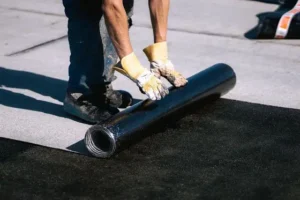Self-adhesive waterproofing membrane is a new type of waterproofing material. Compared to similar materials, it offers advantages such as easy installation, excellent waterproofing performance, and environmental friendliness.
Compared to conventional waterproofing materials, self-adhesive waterproofing membrane has the following advantages:
1. Cold-applied at room temperature, no hot melt required. During installation, simply peel off the release paper and apply directly, making installation extremely convenient and effectively shortening the construction period.
2. High tear strength effectively resists stress from cracking and deformation of the base layer that could damage the waterproofing system.
3. High penetration and impact resistance.
4. Excellent adhesion ensures the continuity and sealing of the membrane’s lap joints.
5. High and low temperature resistance, aging resistance, and long service life.
6. Regarding installation methods: The membrane boasts a sophisticated and simple construction process, strong operability, and low labor intensity. It also boasts fast construction speed and high efficiency, ensuring timely completion. Construction quality is easily guaranteed, meeting high waterproofing requirements.
Process Principle
Self-adhesive rubber asphalt waterproofing membrane is based on an elastomeric asphalt such as SBS, with a polyethylene film, aluminum foil, or no film (double-sided self-adhesive) as the surface material, and a non-stick barrier layer. This waterproofing membrane boasts exceptional bonding strength, and a specially formulated rubber self-adhesive layer ensures a tight seal between the membrane and the substrate, as well as between each other, forming a seamless waterproof layer. It exhibits excellent resistance to acid, alkali, and other chemical corrosion. The HDPE surface provides high tear strength, meeting puncture resistance requirements and effectively resisting stress from cracking and deformation in the substrate, which can damage the waterproofing system.
Process Flow
1. Dry Laying Method
Substrate surface cleaning and repair → Application of the matching base treatment agent → Joint bonding → Positioning and marking of reference lines → Laying of the self-adhesive rubber waterproofing membrane → Rolling and airing → End treatment and overlap → Inspection and acceptance → Application of the protective layer.
2. Wet Laying Method
Clean the base surface → Wet the base (this step is not necessary if the base is already wet) → Position and mark the lines → Mix and apply cement slurry → Lay the membrane → Raise the slurry, vent, and air-dry → Seal the overlapped edges → Finish and seal the membrane → Inspect and accept.
Key Construction Techniques
1. The overall order for laying the membrane is:
Higher spans first, lower spans later; for equal heights, lay farther first, then closer; for the same facade, lay from higher to lower.
2. Primer:
After the base surface has been cleaned and inspected, apply the special base treatment agent evenly to the surface. Apply in a single direction, applying an even thickness without leaks or accumulation. Allow to air-dry until it is tack-free to the touch.
3. Mark the lines and test lay:
Draw the control lines on the primer based on the actual overlap area. Strictly follow the control lines for trial and actual laying of the membrane to ensure the overlap width is 6-7cm (marked on the membrane). According to the site characteristics, the density of the elastic line is determined to ensure that the roll material is pasted straight and will not be pasted crookedly due to cumulative errors. The roll material should be laid in place first and cut correctly according to the required shape before the actual laying can begin.
4. Node treatment:
(1) Treatment of the parapet part: When making cement mortar, the inner corner at the junction of the wall and the roof should be smoothed into a small rounded corner with a radius of about 50mm. After the base surface meets the requirements, a polyurethane waterproof layer is first applied. After the coating is evenly applied, a carcass reinforcement layer (fiberglass cloth) is immediately applied, and then a second polyurethane waterproof layer is applied to ensure a firm bond with the base surface, which is also convenient for the construction of the self-adhesive roll material.
(2) Treatment of the inner and outer corners and pipe openings: The inner and outer corners must be made into a 50mm rounded corner with mortar, and an additional waterproof layer is added, with a fiberglass cloth in the additional layer. At the junction of the pipe mouth and the base surface, after applying the leveling layer, a groove is reserved and filled with sealing material. Then, the rust around the pipe is removed and polished. A waterproof additional layer is provided within 500mm around the pipe mouth, and a fiberglass cloth is added to ensure that the waterproof effect is fully achieved.
5. Large-area paving of self-adhesive rolls: There are two main methods for large-area paving of self-adhesive rolls: stretching and rolling. In actual construction, construction workers can determine the paving method according to the site environment, temperature, sunshine and other conditions, but the basic requirements for exhaustion, compaction and wrinkle prevention remain the same.
(1) Basic requirements: When paving the roll, attention should be paid to aligning with the reference line at all times to avoid deviations that are difficult to correct. When paving the roll, the roll should not be stretched forcefully. After pasting, use a pressure roller to roll from the middle of the roll to both sides to expel air so that the roll is firmly attached to the base layer. Do not remove the isolation paper on the overlapped part of the back of the roll too early to avoid contaminating the adhesive layer or mis-adhering. (2) Stretch-laying method: Align the roll material with the reference line and spread it out in full width. Lift the roll material (including the release paper) from one end and fold it in half along the center line of the roll material. Use a paper cutter to gently cut the edge of the release paper, taking care not to scratch the roll material. Carefully tear off a small section of the release paper about 500mm long from the back of the roll material. Two people work together to peel off the release paper and align it with the reference line to stick and lay it in place. First, spread out half of the roll material in place, pull the peeled release paper back evenly, and slowly pull out the remaining half of the release paper. When stretching and laying, pay attention to the integrity of the pulled release paper. If you find any tear or breakage, stop stretching and laying immediately. Clean up the torn release paper residue before continuing to stretch and lay. (3) Roll-laying method: Peeling the release paper and laying the roll material are done at the same time. During installation, the roll does not need to be unrolled. A steel pipe is inserted into the paper core at the center of the rolled material. Two people, each holding one end of the pipe, lift the roll to the starting point of the roll to be laid. They then extend the roll forward approximately 500mm. Another person peels off the release paper from this section of the roll and rolls it onto the used wrapping paper core. The roll, with the release paper removed, is gently laid along the pre-determined baseline and compacted. After the starting point is laid, one person slowly peels off the release paper and rolls it onto the paper core, moving forward. The two people holding the roll simultaneously roll the roll forward along the baseline. Ensure that the two people moving the roll at the same, coordinated speed are used. Avoid excessive slack during rolling. After laying a section of the roll, use a long-handled roller brush, starting from the starting point, to thoroughly remove any air from underneath the roll. Then, use a large pressure roller or a handheld lightweight vibrator to compact the roll and secure it.
(4) Laying on facades and large slopes: Since the bonding strength between self-adhesive membranes and the base layer is relatively low, the membranes are prone to slipping on facades or large slopes. Therefore, when laying on facades or large slopes, it is advisable to use a handheld gasoline torch to properly heat the adhesive on the bottom of the membrane before laying, venting or rolling. (5) After venting and compacting the large-area membrane, use a small handheld roller to roll the overlapped area, rolling from the inner edge of the overlapped area outward to expel air and firmly adhere. (6) Lap joint sealing: Lap joints: Self-adhesive membrane overlaps are left with an overlapped edge when leaving the factory. When bonding, you only need to peel off the isolation paper. The overlap width is generally 6 to 7 cm. Lap joint sealing: The overlapped area of the short side of the membrane, the end of the membrane, the pipe wrapping, and the special-shaped parts should be sealed with a special sealant for self-adhesive rubber asphalt waterproof membrane. The overlap edge sealing width should not be less than 10 cm. 6. End fixing and sealing: The end of the coil is inserted into the groove (20mm deep × 40mm to 60mm high trapezoidal groove), the metal strip is nailed firmly, and sealed with a special edge sealing paste. (1) The short side joints of two adjacent rows of coils should be staggered by more than 300mm to avoid overlapping of multiple layers of joints and uneven pasting of the coils. When the waterproofing area is large and construction must be carried out in stages, there will be many temporary ends in the middle process. Special sealing paste should be used to make temporary closures. (2) After the coil is pasted, measures should be taken to temporarily cover it to reduce the chance of direct exposure and damage to the coil. The peeled silicone isolation paper should be laid on the coil. This protective paper can also be retained as an isolation layer between the waterproof layer and the protective layer. (3) After pasting, slight surface wrinkles and bubbles may appear under sunlight. This is normal and will not affect its waterproof performance. It will disappear once it is concealed. (4) The waterproof layer should be concealed as soon as possible and should not be exposed to the sun for a long time. Usually, it should be concealed within 24 hours after the completion of the waterproof layer. If a closed water test is performed, the concealment time should be calculated from the end of the closed water test.






